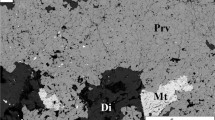Abstract
Pseudoleucite occurs as large megacrysts (giant phenocrysts) in tinguaite at Ghori which is located in the Panwad-Kawant carbonatite-alkalic complex, India. In thin sections the pseudoleucite crystals show mainly an oriented intergrowth of nepheline and orthoclase with additional minerals phases such as white mica, analcime, sodalite and cancrinite. From mineralogy and geochemistry it is inferred that the scheme involving subsolidus breakdown of leucite and subsequent reaction with Na-rich fluids can satisfactorily explain origin of pseudoleucite crystals in tinguaites.
Similar content being viewed by others
References
N. L. Bowen and R. B. Ellestad, “Leucite and Pseudoleucite,” Am. Mineral. 22, 409–415 (1937)
W. A. Deer, R. A. Howie, and J. Zussman, Rock Forming Minerals (Geological Soc., London, 2004), Vol. 4b.
A. Davidson, “Nepheline-K-feldspar Intergrowth from Kaminak Lake, Northwest Territories,” Can. Mineral. 10, 191–206 (1970).
R. F. Fudali, “Experimental Studies Bearing on the Origin of Pseudoleucite from Highwood Mountains of Montana,” Am. Mineral. 23, 837–849 (1963).
J. Gittins, J. J. Fawcett, C. K. Brooks, and J. C. Rucklidge, “Intergrowths of Nepheline-Potassium Feldspar and Kalsilite-Potassium Feldspar: A Re-Examination of the “Pseudo-Leucite Problem,” Contrib. Mineral. Petrol. 73, 119–126 (1980).
A. K. Gupta, and W. S. Fyfe, “Leucite Survival: the Alteration to Analcime,” Can. Mineral. 13, 361–363 (1975).
D. L. Hamilton, and W. S. MacKenzie, “Phase Equilibrium Studies in the System NaAlSiO4-KAlSiO4-SiO2-H2O,” Mineral. Mag. 34, 214–231 (1965).
I. Kushiro, “Si-Al Relation in Clinopyroxenes from Igneous Rocks,” Am. J. Sci. 258, 548–554 (1960).
C. W. Knight, “A New Occurrence of Pseudoleucite,” Am. J. Sci. 21, 286–293 (1906).
A. Korobeinikov, M. Dubrovskil, K. Laajoki, and S. Gehor, “Phase Equilibria in the Undersaturated Part of Petrogeny’s Residua System: a Preliminary Graphical Analysis of its Potassic Field with Potential Implications for the Origin of Pseudoleucite,” Neues Jahrb. Mineral., Monatsh. 6, 241–252 (1998).
M. J. Le Bas, “The Role of Aluminium in Igneous Clinopyroxenes with Relation to their Parentage,” Am. J. Sci. 260, 267–288 (1962).
R. MacDonald, B. G. J. Upton, K. D. Collerson, B. C. Hearn, and A. James, “Potassic Mafic Lavas of the Bearpaw Mountains, Montana: Mineralogy, Chemistry and Origin,” J. Petrol. 33, 305–346 (1992).
E. Pivec, J. Ulrych, and A. Langrova, “On the Origin of Pseudoleucite from Cenozoic Phonolite Dyke from Loučná/Böhmisch Wisenthal Krušné hory/Erzgebirge Mts., Bohemia,” Neues Jahrb. Mineral., Abh. 179(3), 221–238 (2004).
J. Roux, and W.S. MacKenzie, “Sodium in Leucite and its Petrogenetic Significance: An Experimental Study,” Bull. Mineral. 101, 478–484 (1978).
Y. Seki, and G. C. Kennedy, “An Experimental Study on the Leucite-Pseudoleucite Problem,” Am. Mineral. 49, 1267–1280 (1964).
R. N. Sukheswala, and S. F. Sethna, “Giant Pseudoleucites of Ghori, Chhota Udaipur, India,” Am. Mineral. 52, 1904–1910 (1967).
R. N. Sukheswala, and R. K. Avasia, “Carbonatite-Alkalic Complex of Panwad-Kawant, Gujarat, and its Bearing on the Structural Characteristics of the Area,” Bull. Volca. 35(3), 564–578 (1971).
D. Taylor, and W. S. MacKenzie, “A Contribution to the Pseudoleucite Problem,” Contrib. Mineral. Petrol. 49, 321–333 (1975).
D. J. Tempelman-Kluit, “A Re-Examination of Pseudoleucite from Spotted Fawn Creek, West Central Yukon,” Can. J. Earth Sci. 6, 55–62 (1969).
S. G. Viladkar, and R. K. Avasia, “Pyroxenes of Alkaline Rocks of Chhota Udaipur Carbonatite-Alkalic Province, Gujarat, India,” J. Geol. Soc. India., 39, 313–319 (1992).
S. G. Viladkar and R. K. Avasia: “Analcime-Phonolite and Associated Alkaline Rocks of Panwad-Kawant Complex, Gujarat, India,” Chem. Erde 54, 49–66 (1994).
D. H. Watkinson, “Pseudoleucite from Plutonic Alkalic Rock-Carbonatite Complexes,” Can. Mineral. 12, 129–134 (1973).
K. Yagi, “Pseudoleucite from Tzu Chin Shan, Shansi, North China,” Jap. J. Geol. Cogra. 24, 93–100 (1954).
E. G. Zies and F. Chayes, “Pseudoleucite in a Tinguaite from the Bearpaw Mountains, Montana,” J. Petrol. 1, 86–88 (1960).
V. N. Zyrianov, “Phase Relation in the Lcss-Ness-Fsp-(K,Na) Clm System and the Pseudoleucite Problem,” Geochem. Int. 18, 23–31 (1981).
Author information
Authors and Affiliations
Corresponding author
Additional information
The article is published in the original.
Rights and permissions
About this article
Cite this article
Viladkar, S.G. The origin of pseudoleucite in tinguaite, Ghori, India: a Re-evaluation. Petrology 18, 544–554 (2010). https://doi.org/10.1134/S0869591110050061
Received:
Accepted:
Published:
Issue Date:
DOI: https://doi.org/10.1134/S0869591110050061




